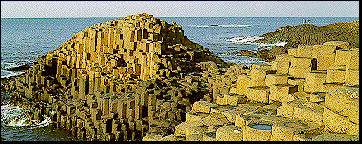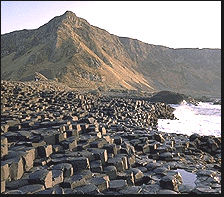 The Giant's Causeway
The Giant's Causeway
Original Official Site of the Northern Ireland Tourist Board

The lunar landscape of the Giant's Causeway, lurking below
the gaunt sea wall where the land ends, must have struck wonder into the hearts of the
ancient Irish.
- 'When the world was moulded and fashioned out of formless chaos, this must have been the bit over - a remnant of chaos.' - Thackeray
Like the early people of North Antrim, Thackeray was very impressed by the strangeness of this place. Like other sophisticated visitors he had read that the Causeway is a geological freak, caused by volcanic eruptions, and cooling lava.
The ancients knew differently: clearly this was giants' work and, more particularly, the work of the giant Finn McCool, the Ulster warrior and commander of the king of Ireland's armies.
Finn could pick thorns out of his heels while running and was capable of amazing feats of strength. Once, during a fight with a Scottish giant, he scooped up a huge clod of earth and flung it at his fleeing rival. The clod fell into the sea and turned into the Isle of Man. The hole it left filled up with water and became Lough Neagh.
Finn was said to inhabit a draughty Antrim headland:
- 'He lived most happy and content, Obeyed no law and paid no rent.'
When he fell in love with a lady giant on Staffa, an island in the Hebrides, he built this wide commodious highway to bring her across to Ulster.
The first historical accounts of the Causeway started appearing in the late 17th century. The Bishop of Derry made one of the first recorded visits in 1692 and the Chevalier De La Tocnaye, who had the good sense to take his umbrella, galloped up to the cliff edge in 1797 when both he and his horse were enraptured by the view.
Before the famous coast road was built in the 1830s visitors complained about the ruggedness of the trip. But there was one shining compensation on the journey: the town where tourists made their last stop before the final push to the Causeway was Bushmills. Ever since 1608 saddle-sore travellers had been revived with magnums of the King's whiskey at the world's oldest (legal) distillery, which is still in business.

The Causeway proper is a mass of basalt columns packed tightly together. The tops of the columns form stepping stones that lead from the cliff foot and disappear under the sea. Altogether there are 40,000 of these stone columns, mostly hexagonal but some with four, five, seven and eight sides. The tallest are about 40 feet high, and the solidified lava in the cliffs is 90 feet thick in places.
A fine circular walk will take you down to the Grand Causeway, past amphitheatres of stone columns and formations with fanciful names like the Honeycomb, the Wishing Well, the Giant's Granny and the King and his Nobles, past Port na Spaniagh where the Spanish Armada ship Girona foundered, past wooden staircase to Benbane Head and back along the cliff top.
Further down the coast, the stunning Carrick-a-rede rope bridge spans a gaping chasm between the coast and a small island used by fishermen. The terrifying eighty foot drop can be crossed via the swinging bridge - not for the faint hearted!
Exploring County Antrim | Giant Causeway | The Castles
of Dunluce & Carickfergus |
The Glens of Antrim |
Northern Ireland Homepage | Travel Tips | Golf | Industrial Heritage | Walking, Hiking & Horseback | Activities | Calendar of Events | Transportation | Cuisine and Restaurants | Birdwatching | Fishing | Ancestral Heritage | County Antrim | County Armagh | City of Belfast | County Down | County Fermanagh | County Londonderry | County Tyrone | Tour Operators | InterKnowledge Home Page
Copyright (c) 1995-1997 interKnowledge Corp. All rights reserved.
